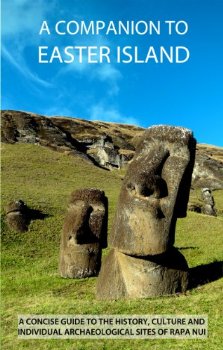Amaze Others With Random Knowledge of Easter Island

So I’m going to do my best not to turn the blog into “Heels First on Easter Island” but I’m so excited about my upcoming trip that I might not be able to help it. (It’s time for Jeanne to bring out the Club Carlson posts!) That said, I just found a great guide book for anyone who’s planning a visit or just wants a thorough and entertaining overview of the island’s history: A Companion to Easter Island (Guide To Rapa Nui)
When I was searching for a guide book, I quickly realized what the author, James Grant Peterkin writes about. You either get one chapter of info in a guidebook about Chile or South America, or you’re going to get bogged down in scientific articles and research. So after reading all the great reviews of the book, I decided to spend the $10 on the Kindle version.
Great investment! The whole boring flight out to San Francisco last weekend I was absorbed in the 100+ pages about the island’s history, sights, and recommendations for when best to photograph things.
While I’d previously done research on what sites to see and how long I’d need, I hadn’t really delved into the history, which made me realize how many misconceptions I still had! I will be much better informed upon arrival, but I’ll admit a little of the mystery and randomness I treasured has been taken away…
- They don’t know why the statues are there –Â actually they do. All the tribes on Easter Island built the statues for religious and protection purposes.Â
- The statues are just giant heads — the heads are only 1/4-1/3 of the statue. Those famous pictures of heads spread out across the hillside is a filled-in quarry with most of the statue buried beneath.
- The original descendants disappeared/died off — actually many of the descendants are still on the Island, including folks who remember living in the traditional caves when they were growing up.
And in more recent history…
- I learned from a slightly younger friend, (the statues were still a mystery when I was growing up) Easter Island is commonly used by conservationists as an example of what the rest of the world could become. The inhabitants became so obsessed with building statues they depleted all their resources in pursuit of bigger and better and nearly became extinct.
- Chile leased the island to sheep farmers for the first half of the 20th century and all the inhabitants were not allowed to live anywhere on the island except in the tiny village, nor were they allowed to leave.
And then there’s the one other thing that never occurred to me, but could dramatically impact my travels. There are only two public restrooms outside of the one town. I like to hydrate extensively when taking short international trips.
However, a stomach virus years ago on an all-day hike through the West Virginia mountains has left me extremely disinclined towards anything not man-made. So my visions of meandering through the various sites on my own time might have to become dramatically more scheduled or dehydrated. #firstworldproblem
So anyway, now you too can bore and amaze your friends with your new Easter Island knowledge (except for that last point)! And I highly recommend getting the book, even if you’re not planning a trip there.
—————-
Never miss another post! Sign up to receive new content via e-mail or RSS Feed.
Get real-time updates on our travel adventures via Twitter feed (and say hi!) and like us on Facebook.
Heels First is the travels and tribulations of two twenty-something frequent fliers jumping into the world of travel. Join Keri and Jeanne as they tackle mileage runs, elite status, and of course–the perfect travel accessories.
Full Disclosure: Heels First may receive a commission for purchases made through Amazon links on our site, like the one above. So if you like our content and recommendations, thank you for the support!

